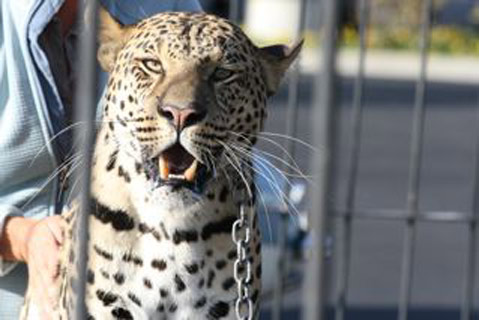Leopard in a Box
Wild Animal Attraction

The other day, just before nightfall, I accompanied my friend to an event attended by about 100 people. Cartoon-character balloons larger than buildings bobbed in the near distance and bright, flickering fluorescent lights illuminated deals of the century. The crowd mingled quietly. Toddlers and young children held onto their parents, who themselves seemed to bob like the enormous balloons.
My date was there to make an appearance and to see an old friend. I selfishly went to observe and to talk to the leopard.
At the time I arrived, the crowd was not showing much interest in the spotted leopard (Panthera pardus). I watched before I approached. He had three handlers who took turns holding his chained leash inside a cage.
I immediately noticed that the leopard, if he wanted to, could easily scale the 15-foot fencing and get away. I concluded that the cage was more to keep the humans spectators away. The handlers asked him to “sit,” “stay,” “stand on box,” and “beg.” Even I, a former animal trainer, thought, “How humiliating.”
The leopard was long, lean, and graceful. His walked with complete and utter awareness. When he was not putting on a show he watched the crowd with an acute eye. “What is he watching?” I thought. He stood up and sniffed, crouched down, peered into the crowd, and then lay down again, still watching. I too scrutinized the crowd, thinking, “What is he so intent on?” Then I noticed.
He was watching the children. He turned to me. “I can hear you in my head,” I whispered.
“Tell them my transport cage is slippery,” he said back. “My woman trainer. She knows more about me than the others. Will you tell her?” he asked. He huffed and continued watching the children.
I spoke to the handlers. They were open to my communications and generous with information. They spoke of working with exotics to educate the public. They said, “Most people think all big cats are lions.” I believed them. Their sense of mission was compelling, and their training methods were clearly humane.
But something didn’t sit right with me. I live with Maia, a wolf dog, who has been stuck between two very different worlds: domestic life and her wild instincts. Maia and the leopard are similar in their bodies. Both of them calmly survey the perimeter and notice every sound, smell, and movement.
“Thank you for restraining yourself and not going after the children,” I said to the leopard. “You noticed,” he answered. “Yes, and so do your handlers,” I replied. I took a breath and asked, “What is life like for you?”
The leopard got up and lay closer to me, but he still kept his eye on the crowd, “It feels like something is missing. Like I should be able to run faster and farther. It feels like I have muscles that are not used or developed. It feels like I should hunt down my own prey and that the food I eat should be my pick, not theirs. I also feel like I am missing something in my diet. If it was fresher maybe I would feel more satisfied.”
“How do you feel about your training?” I asked.
“It gives me something to do and something to focus on. I get bored easily. I feel like I live to fulfill a need in them. I love them. I see their kindness, but I feel like their prisoner.”
“What do you want to tell humans?” I questioned.
“Don’t take us from wild. We know what we are missing. We don’t like your noises. If you are going to keep us, give us a place where we hear natural noises only. So many of your sounds hurt us. If I had a choice, I would leave my human friends and live in the wild.”
Just as he spoke a car drove by and honked its horn.



